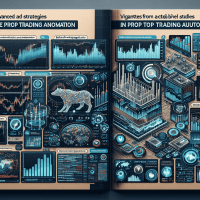Proven Prop Trading Automation: Expert Strategies & Tools
In today’s competitive markets, proprietary trading firms and individual traders alike are harnessing the power of automation. Prop trading automation is not just about deploying algorithms; it’s about implementing robust, data-driven strategies to optimize backtesting, reduce risks, and improve overall performance. This comprehensive guide provides an in-depth look at the latest trends and expert advice needed to thrive in the prop trading arena.
Understanding the Landscape of Prop Trading Automation
The evolution of prop trading has brought a paradigm shift in how trading strategies are developed and deployed. Automation has emerged as a critical component, facilitating rapid analysis and execution. Whether you are a junior trader eager to automate your first strategy or a seasoned quant refining complex backtesting scenarios, understanding the nuances of prop trading automation is paramount.
This visual provides a glimpse into a high-performance trading dashboard, commonly seen in platforms like TradingView and MetaTrader 5, illustrating real-time data integration and backtesting report summaries.
Essential Automated Tools for Prop Trading
Modern prop trading environments require state-of-the-art tools that not only backtest strategies efficiently, but also integrate seamlessly with broker platforms and data feeds. Here is a detailed review of some of the industry’s most respected backtesting and trade automation software:
TradingView
Backtesting Features: TradingView utilizes vectorized backtesting algorithms and offers both event-driven and historical simulation modes, with detailed performance metrics such as Sharpe ratio and drawdown calculations. It supports automated parameter optimization and stress testing.
Data and Integration: With extensive historical data covering various asset classes and real-time feeds, TradingView is ideal for both retail and prop trading. Integrates with popular brokers and has API access for advanced customizations.
Pricing and Use Cases: Offering affordable monthly subscriptions with trial options, it is widely popular among collaborative teams and individual traders looking for robust charting and backtesting tools.
MetaTrader 5
Backtesting Features: Known for its MQL5 engine, MetaTrader 5 provides event-driven backtesting with capabilities to handle commissions, slippage, and optimization. Advanced report generation is a highlight.
Data and Integration: Provides deep historical data, especially well-suited for forex and CFD trading. Seamless integration with multiple brokers and external analytics platforms makes it an industry staple.
Pricing and Use Cases: Free to use for retail trading, with scalable features that have also attracted small to medium prop trading firms.
NinjaTrader
Backtesting Features: Delivers powerful, event-driven backtesting with custom strategy development in C#. Includes built-in optimization and scenario analysis capabilities.
Data and Integration: Offers high-quality historical data and supports direct broker integrations for real-time executions. Extensible through third-party add-ons.
Pricing and Use Cases: Provides both free and premium versions, targeting a wide range of users from individual traders to high-frequency trading operations.
Additional Tools to Consider
Other notable tools include QuantConnect (robust algorithmic trading with cloud integration), Backtrader (Python-based backtesting, ideal for custom strategies), and NinjaTrader as mentioned. Each tool brings distinct features that help prop traders automate routine tasks, generate detailed performance reports, and minimize biases in backtesting.
Comparing Prop Trading Automation Tools
Below is a comparative table elucidating key features of popular platforms:
| Tool | Backtesting Features | Data Quality | Integration | Pricing | Best For |
|---|---|---|---|---|---|
| TradingView | Vectorized, parameter optimization | Extensive, multi-asset | API & broker integration | Subscription-based | Retail & prop firms |
| MetaTrader 5 | Event-driven, detailed reports | Deep historical data | Multiple broker links | Free with broker account | Forex and CFD traders |
| NinjaTrader | C# custom backtesting, stress testing | High-quality feeds | Extensive add-ons & API | Free/Premium options | High-frequency trading |
Advanced Backtesting Concepts for Prop Trading
Even with premium tools, backtesting can introduce biases if not diligently managed. Consider these pitfalls and advanced techniques:
Common Pitfalls in Backtesting
- Overfitting: Excessively tuning strategies to historical data which may not perform in live markets.
- Survivorship Bias: Including only successful trades while ignoring failed ones, skewing results.
- Look-Ahead Bias: Using information that wouldn’t have been available at the time of trade execution.
- Data Snooping: Repeated strategy adjustments based on multiple tests across the same dataset.
Mitigation strategies include using robust out-of-sample testing, walk-forward optimization, and statistically significant sample sizes.
Walk-Forward Optimization vs. Traditional Backtesting
Walk-forward testing involves optimizing your model on a rolling window of data, and then testing on the subsequent period. This approach reduces the risk of overfitting by ensuring that the strategy performs consistently over different market cycles. In contrast, traditional backtesting typically runs a single simulation over historical data, which might not capture the evolving market dynamics.
Integrating Backtesting with Forward Testing
Before fully deploying a new strategy, it is crucial to validate its performance through paper trading. This hybrid approach limits live market exposure and confirms that the backtested results translate into real-time, viable outcomes. Key metrics to watch include Sharpe ratios, maximum drawdown, and profit factors.
Data Quality: The Backbone of Successful Backtesting
Reliable data is essential for accurate backtesting. Consider the following tips:
- Tick Data vs. Bar Data: Tick data offers granular insights, but be mindful of storage requirements and processing complexity. Bar data, though less detailed, simplifies analysis.
- Handling Missing Data: Impute or adjust datasets to ensure continuity and consistency, especially during periods of market anomalies.
- Adjusting for Corporate Actions: Ensure datasets account for dividends, splits, or other corporate events that affect price movements.
Regulatory Compliance in Prop Trading
Staying compliant is non-negotiable for prop trading firms. Current regulations such as MiFID II, ESMA guidelines, and NFA rules impact everything from trade reporting to risk management. Firms must ensure that their automated systems are designed with compliance in mind, incorporating proper audit trails and risk disclosures. This not only mitigates regulatory risks but also builds trust with stakeholders.
Real-World Case Study: Overcoming Backtesting Biases
Consider a mid-sized prop firm that had been relying on traditional backtesting methods. The team faced issues with overfitting and inconsistent performance during live testing. After integrating TradingView for its vectorized backtesting capabilities and applying walk-forward optimization methods, the firm noted a 15% improvement in its Sharpe ratio and a significant reduction in maximum drawdown. Detailed reports and scenario analysis allowed risk managers to adjust strategies dynamically, ultimately leading to more consistent returns.
Expert Guidance: Pro Tips for Navigating Prop Trading Automation
Pro Tip: Regularly update your backtesting algorithms and ensure that you continuously source quality data. Automation tools are only as effective as the data they are fed.
Industry Insight: Integration between backtesting and live trading platforms is key. Leverage API connectivity to instantly translate backtested strategies into paper trading models for further validation.
This screenshot illustrates a typical backtesting report from MetaTrader 5, emphasizing vital metrics like drawdown, Sharpe ratios, and parameter optimization results that are critical for risk management.
Implementing Automated Prop Trading Strategies
Automation in prop trading not only improves efficiency but also provides a systematic approach to risk management and performance analysis. Below is a sample Python snippet using Backtrader, a widely recognized tool for automated backtesting:
import backtrader as bt
class TestStrategy(bt.Strategy):
def __init__(self):
self.sma = bt.indicators.SimpleMovingAverage(self.data.close, period=15)
def next(self):
if self.data.close[0] > self.sma[0] and not self.position:
self.buy(size=100)
elif self.data.close[0] < self.sma[0] and self.position:
self.sell(size=100)
cerebro = bt.Cerebro()
data = bt.feeds.YahooFinanceData(dataname='AAPL', fromdate=datetime(2020, 1, 1), todate=datetime(2021, 1, 1))
cerebro.adddata(data)
cerebro.addstrategy(TestStrategy)
results = cerebro.run()
cerebro.plot()
This snippet demonstrates a simple moving average crossover strategy. Adjust the parameters, incorporate out-of-sample testing, and observe how algorithmic decisions match historical data for robust risk management.
Critical Next Steps for Prop Trading Professionals
As you refine your prop trading automation strategy, consider these actionable steps:
- Download our detailed Risk Management Checklist to ensure your strategies meet industry benchmarks.
- Join our upcoming webinar on advanced backtesting techniques for prop trading, where experts discuss real-world scenarios and regulatory impacts.
- Explore related articles on our site such as Advanced Trading Strategies and Risk Management in Prop Trading for deeper insights.
Conclusion
Prop trading automation is transforming the landscape of modern trading. By utilizing state-of-the-art tools like TradingView, MetaTrader 5, and NinjaTrader, traders can optimize their strategies and future-proof their operations. Remember, the key to success lies in balancing robust backtesting with strict regulatory compliance and continuous adaptation to new market data.
For a complete roadmap including a step-by-step guide, download our Risk Management Checklist and join our community of trading experts who are shaping the future of prop trading.
As of October 2023, staying ahead means continuous innovation, rigorous testing, and unyielding adherence to compliance standards. Start optimizing your prop trading journey today!







